Saturdays, noon to 1 p.m. ET on WICR 88.7 FM.
Or listen live from anywhere on WICR Online!
Our call-in number during the show: (317) 788-3314

October 6, 2018
Chautauquas across Indiana, then and now
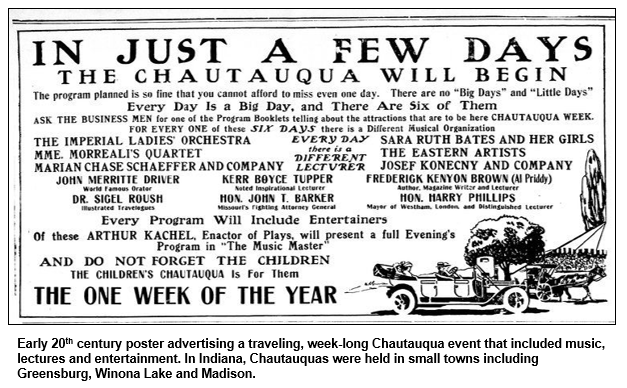
More than 100 years ago, Helen Keller visited Greensburg, Ind.
She also came to Winona Lake, the resort town in far-northern Indiana. So did William Jennings Bryan and composer John Philip Sousa, best known for his march "The Stars and Stripes Forever."
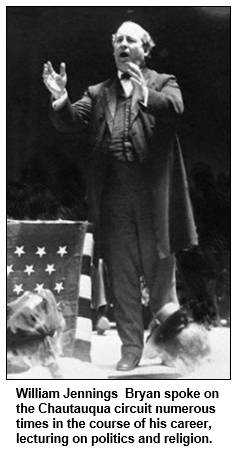
They came to communities that put together a Chautauqua, a cultural, educational and entertainment assembly that was an unforgettable, enriching experience for thousands of Hoosiers.
The local events were part of a "circuit Chautauqua" that emanated from the "mother" gathering, which began in 1874 on the shores of idyllic Lake Chautauqua in western New York.
Now overseen by the Chautauqua Institution and attended by more than 100,000 people over a nine-week period each summer, the New York gathering has continued uninterrupted for over 170 years since its original inception. Alas, the circuit Chautauquas had ceased operation by the onset of the Great Depression.
In recent years, though, some Indiana communities - including Greensburg and the scenic Ohio River town of Madison - have revived their Chautauqua heritage.
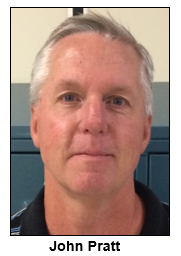
On our show, Nelson's guests also will include Terry White, an author and historian in Winona Lake, the setting for one of the largest circuit Chautauquas in the entire country. According to Terry's book Winona Lake at 100 (2013), Helen Keller spoke in 1915 at the town's Chautauqua. In 1897, notable visitors - who typically traveled by train on the circuit - included African-American social reformer and educator Booker T. Washington. In 1928, Winona Lake residents enjoyed humorist Will Rogers.

Some history facts:
- According to Chautauqua: An American Narrative a PBS-TV documentary, the original gathering in New York was founded as an assembly to train Sunday school teachers.
- Among the wealthy Americans who traveled to New York during the early years of the main Chautauqua was Clement Studebaker, the eldest of the five wagon and car-making brothers in South Bend. For many upper-class families, a visit to the gathering at Lake Chautauqua became - and remains - an annual tradition.
- After Will Rogers' trip to Winona Lake, he wrote a syndicated newspaper column about the visit entitled "You Can Hear a Holy Trombone at Winona."
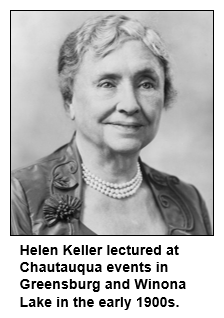
More than 100 years ago, many small towns were able to arrange appearances by famous Americans like Helen Keller if a railroad line passed through the area; celebrities often spoke in Greensburg, for example, because they were traveling between the larger cities of Cincinnati and Indianapolis.
Even the tiny, unincorporated community of Burney - which is near Greensburg in Decatur County - hosted John Philip Sousa, according to our guest John Pratt.
In Winona Lake, a local music director and songleader named James Heaton became affectionately known as "Mr. Chautauqua," according to Terry White. A native of England, Heaton moved to Winona Lake in 1908, managed the "platform programs" for about 20 years and served on stage as a master of ceremonies.
Clement Studebaker (1831-1901), president of the Studebaker Brothers Manufacturing Company, served for a few years as board president of the New York-based Chautauqua Institute. Other members of the Studebaker family also periodically served on the board.
Roadtrip: Out to Old Aunt Mary's in Greenfield
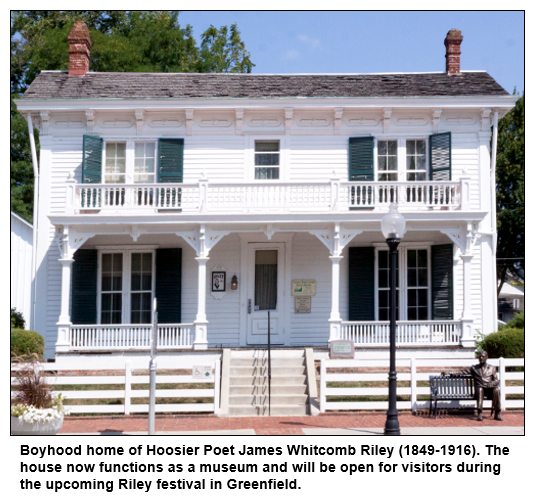
Guest Roadtripper Jeff Kamm invites us on a jaunt to quintessential small-town Indiana: Greenfield, located about 30 minutes east of Indianapolis in Hancock County.
If you associate Greenfield with the "The Hoosier Poet," James Whitcomb Riley, there's good reason: the famed author and creator of the character "Little Orphant Annie" was born in Greenfield in 1849. His childhood home there is now a museum that promises to "take you back to life in the 1850s and '6os" when you stop in for a visit (open April through October).
And if you're a fan of James Whitcomb Riley, Jeff tells us that now is the perfect time to visit Greenfield: This weekend marks the town's annual celebration of his birthday with a festival featuring over 400 vendors, a parade and other entertainment.
Each year the festival selects one of Riley's poems to set the tone: this year it's "Out to Old Aunt Mary's," a tale of a summertime trip to visit a beloved family member. With a little luck, the weather for the festival this year will include "sunshine spread as thick as butter on country bread," as the poem goes.
And while you're out Greenfield way, consider a side trip to nearby Tuttle's Orchards, where you can pick apples, pumpkins (a.k.a " punkins" - the frosty sort - to Riley fans!) and sample local delicacies.
History Mystery
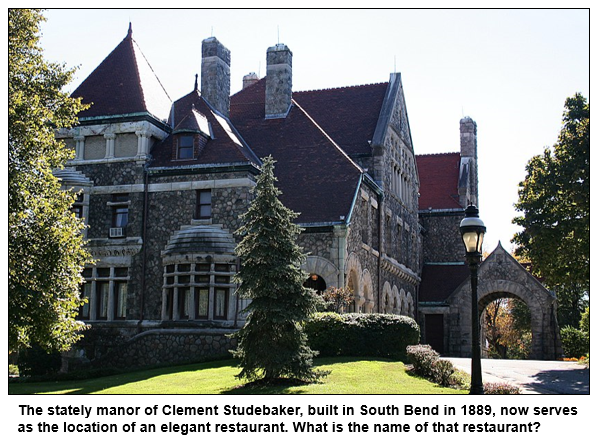
Clement Studebaker, the eldest of the brothers who founded a business that made wagons (and later cars) lived in an ornate mansion in South Bend more than 120 years ago, when he regularly attended Chautauqua gatherings in New York.
Today, the historic Studebaker mansion - once the setting for many of the family's grand parties - is the site of one of the best-known restaurants in South Bend.
The restaurant carries the name that Clement Studebaker gave to the mansion when his majestic home was being built in the 1880s. The Romanesque-style landmark is listed on the National Register of Historic Places.
Question: What is the name of the Studebaker mansion-turned-restaurant in South Bend?
The call-in number is (317) 788-3314. Please do not call in to the show until you hear Nelson pose the question on the air, and please do not try to win if you have won any other prize on WICR during the last two months. You must be willing to give your first name to our engineer, you must answer the question correctly on the air and you must be willing to give your mailing address to our engineer so we can mail the prize pack to you. The prizes this week are six tickets to the Indianapolis Scottish Highland Games to be held Saturday Oct. 13 at German Park in Indianapolis, courtesy of the Scottish Society of Indianapolis, as well as a gift certificate to Story Inn in Brown County, courtesy of Story Inn.
Honoring veterans, gaining insight

Nelson Price, host and historian
Molly Head, producer/project manager, (317) 927-9101
Michael Armbruster, associate producer
Cheryl Lamb, administrative manager
Richard Sullivan, senior tech consultant
Pam Fraizer, graphic designer
Garry Chilluffo, special events consultant

Please tell our sponsors that you appreciate their support!

 Acknowledgments to Monomedia, Visit Indy, WICR-FM, Fraizer Designs, Heritage Photo & Research Services, Henri Pensis, Chris Shoulders, Aaron Duvall, and many other individuals and organizations. We are an independently produced program and are self-supporting through organizational sponsorship, and by individual contribution at the yellow button on our newsletter or website. For organizational sponsorship, which includes logos, links, and credits in the show, contact Molly Head at (317) 927-9101 or email her at molly@hoosierhistorylive.org. And any of our podcasts can be sponsored for a nominal fee.
Acknowledgments to Monomedia, Visit Indy, WICR-FM, Fraizer Designs, Heritage Photo & Research Services, Henri Pensis, Chris Shoulders, Aaron Duvall, and many other individuals and organizations. We are an independently produced program and are self-supporting through organizational sponsorship, and by individual contribution at the yellow button on our newsletter or website. For organizational sponsorship, which includes logos, links, and credits in the show, contact Molly Head at (317) 927-9101 or email her at molly@hoosierhistorylive.org. And any of our podcasts can be sponsored for a nominal fee.
Thank you!
We'd like to thank the following recent, new and renewal contributors whose donations help make this show possible!
- Dave and Theresa Berghoff
- Ann S. Frick
- Adam Rickert
- Carol Bacon
- Robin Jarrett
Octcober 13, 2018 - Upcoming
Have you heard of The Hoosier Hot Shots?
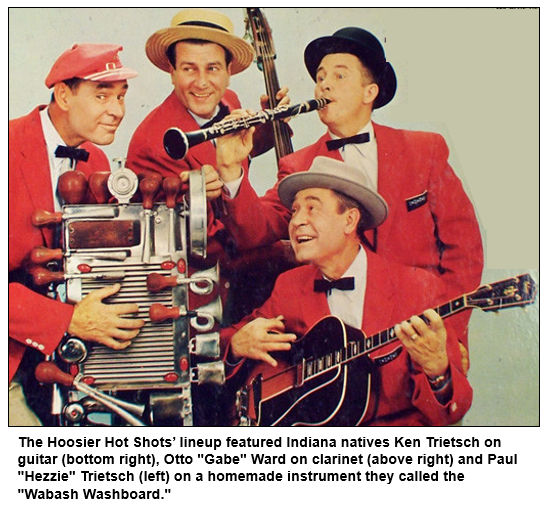
With percussion instruments that included a makeshift washboard and a stage routine punctuated by comic banter between their musical numbers, they were nationally known entertainers from the 1920s through the mid-1940s.
The Hoosier Hot Shots were regulars on National Barn Dance, one of the most popular radio shows in the country, broadcast on WLS-AM in Chicago. They were featured as a novelty act in Western movies starring Gene Autry and slapstick comedies with the Three Stooges. They were headliners in vaudeville venues and recorded much of their music at Gennett Studios in Richmond, Ind., which launched the recording careers of many American jazz, blues, country and gospel stars during the era.
The three primary members of the Hot Shots band were Otto "Gabe" Ward, who was born in Knightstown and grew up in Elwood, and two brothers, Ken and Paul "Hezzie" Trietsch, who hailed from the small town of Arcadia in Hamilton County. The Indiana State Museum periodically has exhibited Gabe Ward's clarinet and Hezzie's unusual washboard instrument, which he made by hand; the exhibits also have included vintage posters for some of their 21 movies.
As we turn our spotlight on the colorful and quirky Hoosier Hot Shots, Nelson will be joined in studio by Todd Gould, a senior producer/director at WTIU-TV in Bloomington and a broadcasting instructor at Indiana University. For three years, Todd and his WTIU colleagues have been working on a documentary about Gennett, where, in addition to the Hot Shots, emerging stars like Hoagy Carmichael, Louis Armstrong and Jelly Roll Morton recorded. (Hoosier History Live explored the impact of the recording history made at Gennett Studios on a show in 2013.)
In an article about the Hoosier Hot Shots in an upcoming issue of Traces, the Indiana Historical Society's magazine, Todd writes:
"During two of the most tumultuous times in our nation's history, the Great Depression and World War II, Americans found comfort in the silly songs and crazy antics of a band from the flatlands of central Indiana ... Their sound and lyrics were unlike anything Americans in the early 20th Century had ever heard before."
A sample lyric from a Hot Shots song:
From the Indies to the Andes in his undiesAnd he never took a shave except on Mondays
He didn't eat a thing but chocolate sundaes
'Twas a very, very daring thing to do.
In addition to Todd Gould, Nelson will be joined in-studio by Hamilton County historian David Heighway, who has researched the deep roots of the Trietsch family in the county. Ken Trietsch (rhymes with “beach”) played the guitar and banjo while Hezzie played the washboard - as well as cowbells, horns, pie tins and, as Todd puts it in his Traces article, "other assorted gear that looked more at home in a farmhouse kitchen than on a stage."
Periodically during our show, we plan to feature brief excerpts of the Hoosier Hot Shots' recordings to give listeners a flavor of their distinctive routines.
© 2018 Hoosier History Live. All rights reserved.
|





